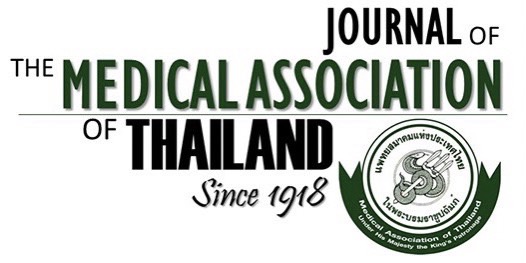Computed Tomographic Findings in Non-traumatic Hemorrhagic Stroke
Pipat Chiewvit MD*, Nasuda Danchaivijitr MD*, Yongchai Nilanont MD**, Niphon Poungvarin MD**
Affiliation : * Department of Radiology, Faculty of Medicine Siriraj Hospital, Mahidol University, Bangkok, Thailand ** Department of Internal Medicine, Faculty of Medicine Siriraj Hospital, Mahidol University, Bangkok, Thailand
Objective : To analyze CT findings in hemorrhagic stroke patients correlation with clinical outcome and
assess the interobserver agreement of hemorrhagic stroke identification on CT imaging.
Material and Method: CT imaging features of 131 cases and clinical data were verified and collected at
Siriraj Hospital from Jan 2004 to Dec 2005 and retrospectively analyzed for type, location, mass effect, size of
hemorrhage, intraventricular extension, initial level of consciousness (GCS), hospital length of stay and
patient outcome. The percentages, predictive values, kappa were calculated.
Results : From all types of hemorrhagic stroke, intracerebral hemorrhage remains a common and devastating
clinical problem. The most common site was the thalamus and basal ganglia. In the present study, the authors
found that fifty-three cases (53/131 cases, 40.5%) with thalamic-ganglionic hemorrhage, nineteen cases
(19/131 cases, 14.5%) in lobar hemorrhage, five cases (5/131 cases, 3.8%) in cerebellum, five cases (5/131
cases, 3.8%) in brainstem and eight cases (8/131 cases, 6.1%) occurred in multiple locations. There were
twenty-five cases (25/131 cases, 19.1%) of subarachnoid hemorrhage, thirteen cases (13/131 cases, 9.9%) of
subdural hemorrhage and three cases (3/131 cases, 2.3%) of intraventricular hemorrhage. Two variables on
CT imaging, identified as significant as early mortality predictors, were hematoma volume more than 60 cm3,
and presence of intraventricular hemorrhage extension (p < 0.05). The mass effect defined as midline and/or
enlargement of contralateral ventricle was not significant (p = 0.067). The present study found concordance
between CT brain interpretation by two neuroradiologists for the type of hemorrhagic stroke was very good,
Kappa = 0.861 as well as for location was 0.866.
Conclusion : CT imaging is an imaging instrument for early identification of hemorrhagic stroke patients and
providing imaging evidence of high mortality risk.
Keywords : Computed Tomographic finding, Computed Tomography, Stroke, Hemorrhagic stroke, Non- traumatic hemorrhagic stroke



